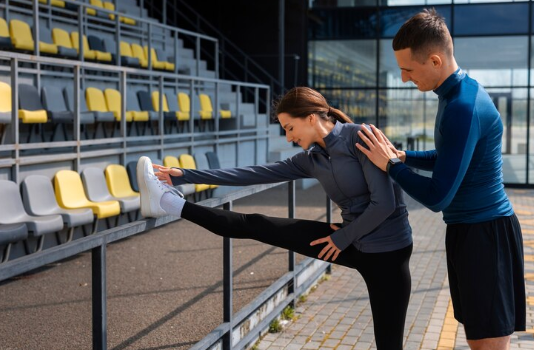In the exhilarating world of sports, where adrenaline flows and competition is fierce, ensuring the safety of athletes is paramount. From professional leagues to amateur tournaments, injuries are an unfortunate reality that can not only derail a player’s season but also have long-term consequences for their health and well-being.
However, with the right strategies and precautions in place, many injuries can be prevented, allowing athletes to perform at their best while minimizing the risk of harm.
Understanding the Risks
Before diving into specific prevention strategies, it’s essential to understand the common types of injuries athletes face. In sports ranging from football and soccer to basketball and gymnastics, injuries can vary widely in type and severity. Some of the most prevalent injuries include.
Sprains and Strains:
These are among the most common sports injuries, involving stretched or torn ligaments (sprains) and muscles or tendons (strains).
Fractures:
Bone fractures occur when excessive force is applied, leading to a break or crack in the bone. They can range from minor hairline fractures to severe breaks requiring surgery.
Concussions:
Head injuries, particularly concussions, are a significant concern in contact sports like football, rugby, and hockey. They result from a sudden impact or jolt to the head, leading to temporary cognitive impairment.
Overuse Injuries:
These occur gradually over time due to repetitive stress on muscles, tendons, and bones. Common examples include stress fractures, tendonitis, and bursitis.
Pre-Game Preparation
Prevention begins long before the first whistle blows or the starting gun fires. Proper pre-game preparation can significantly reduce the likelihood of injuries.
Here are some key steps athletes and coaches can take:
Warm-Up Routine:
A thorough warm-up is essential to prepare the body for physical activity. Dynamic stretches, light cardio, and sport-specific drills help increase blood flow to muscles, improve flexibility, and reduce the risk of strains and sprains.
Strength and Conditioning:
A well-rounded strength and conditioning program can enhance muscular strength, endurance, and stability, reducing the risk of injuries. Focus on exercises that target key muscle groups used in your sport and include both strength training and functional movements.
Proper Equipment:
Ensuring you have the appropriate gear is fundamental in preventing injuries. Whether it entails helmets, pads, braces, or the correct footwear, each piece of equipment must fit properly, be well-maintained, and offer sufficient protection tailored to the unique requirements of the sport. Additionally, don’t overlook the importance of a custom mouthguard, as it can significantly reduce the risk of dental and facial injuries during athletic activities.
Hydration and Nutrition:
Staying hydrated and fueling your body with the right nutrients is vital for peak performance and injury prevention. Maintain proper hydration before, during, and after activity, and fuel up with a balanced diet rich in carbohydrates, protein, healthy fats, vitamins, and minerals.
In-Game Strategies
Once the game or competition is underway, athletes must remain vigilant and employ certain strategies to minimize injury risk:
Technique and Form:
Proper technique is not only essential for optimal performance but also for injury prevention. Coaches should emphasize correct form and mechanics during training, focusing on safe and efficient movement patterns.
Rest and Recovery:
Fatigue increases the risk of injuries, so it’s crucial to listen to your body and take breaks when needed. Adequate rest and recovery between games or intense training sessions allow muscles to repair and regenerate, reducing the likelihood of overuse injuries.
Stay Alert:
Pay attention to your surroundings and be aware of potential hazards on the field or court. Whether it’s uneven terrain, other players, or equipment, staying alert can help you avoid collisions and accidents.
Communication:
Effective communication among teammates is essential, particularly in team sports where coordination and cooperation are critical. Clear communication can help prevent collisions, ensure proper positioning, and minimize the risk of injury.
Post-Game Recovery
Injuries can still occur despite the best prevention efforts, so it’s essential to know how to respond and recover effectively:
Immediate Treatment:
For acute injuries like sprains, strains, or bruises, immediate treatment is crucial. R.I.C.E. (Rest, Ice, Compression, Elevation) is a standard protocol for managing acute injuries and reducing swelling and pain.
Seek Medical Attention:
If an injury is severe or doesn’t improve with self-care, seek medical attention promptly. A healthcare professional can assess the injury, provide a diagnosis, and recommend appropriate treatment and rehabilitation.
Rehabilitation:
Rehabilitation plays a vital role in the recovery process, helping athletes regain strength, mobility, and function after an injury. Work closely with a physical therapist or sports medicine specialist to develop a personalized rehab plan tailored to your needs and goals.
Gradual Return to Play:
Rushing back into activity too soon can increase the risk of re-injury. Follow your healthcare provider’s guidance and gradually ease back into training and competition once you’re fully healed and cleared to play.
In Conclusion
Injuries are an inevitable part of sports, but they don’t have to be a foregone conclusion. By implementing the right strategies and precautions, athletes can significantly reduce the risk of injuries and stay safe while pursuing their athletic goals. From proper pre-game preparation and in-game strategies to post-game recovery and rehabilitation, prioritizing safety is essential for long-term health and success in sports. So remember, play hard, play smart, and above all, play safe.






